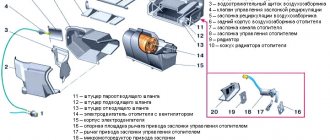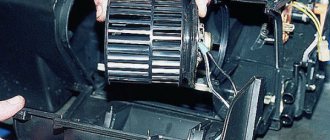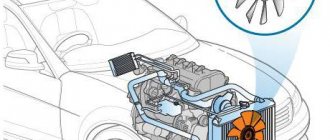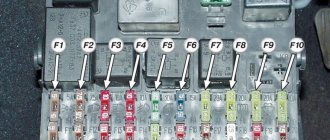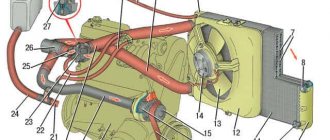As soon as the first cold weather arrives, some drivers are faced with a non-working stove in their VAZ 2110. The reasons may be different, malfunctions in mechanics and electronics.
To find out the causes of the breakdown and fix the problem, first of all you should study the Lada heating system and the essence of the stove’s operation.
In the course of their work, the mechanics were able to identify a number of the most common causes of a non-working stove on a VAZ 2110:
- the heater operates in one temperature mode at a certain speed or the temperature is not regulated at all;
- the shutters responsible for air distribution and then do not work;
- breakdown of the damper temperature sensor (located on the ceiling of the car);
- breakdown of the SAUO controller;
- Antifreeze heater radiator leaking.
Once all of the above points have been diagnosed and the cause of the stove failure has been determined, you can proceed directly to the repair.
Checking the operation of the automatic control system
To diagnose this system, you need to have a multimeter so you can measure the current on the pink and brown wires.
The voltage can have different values, it depends on which controller is built into the car. For example, in older cars - before 2002 - heater control controllers 1303.3854 were installed, in this case the voltage at the minimum position changes in about 14 seconds, and at the maximum value it is supplied stably. Therefore, if the voltage of the ACS unit at the output has a constant value, it is faulty. On newer cars since 2003, the built-in unit is 1323.3854, and the stove is 2111-8101012.
When faults are found in the controller, the dampers may be faulty. To determine other reasons for the breakdown of the car's 2110-12 heater, you will most likely need to disassemble the heater.
Poor heating at idle
If you suddenly experience a flow of cold air while the engine is warm and the heater is on, there are probably problems with the thermostat or pump. The cause of this phenomenon may be a damaged cylinder head gasket. A broken gasket gives the effect of an airy state. But this is not the worst situation, it is much worse if the reason why the stove does not heat well is a non-working pump.
A failed pump will not circulate coolant, causing the engine to overheat. So if the heater on your car begins to heat worse, you need to check the performance of the pump. A faulty heater valve also affects the flow of warm air into the car interior. If it stops working normally, the inlet hose will be hot and the outlet hose will be cold.
Diagnostics of heater system shutters VAZ 21I0
The VAZ 2110 stove has two shutters.
Through one, cold air is absorbed, and through the other, hot air is supplied. If the wire mechanism malfunctions, you may encounter the following disadvantages:
- The stove doesn't heat well
- There is no hot air flow at all,
- high air supply temperature,
- temperature is not regulated.
Shutters can have various types of breakdowns:
- It happens that the damper gets stuck or malfunctions, and the micromotor gearbox can also fail.
- Also, the damper may stop functioning due to rust, because there are two types of dampers.
There are old and modern samples of shutters,
- old ones - made of plastic and sealed with foam rubber,
- and modern ones are made of metal with a rubber seal.
If you cannot hear the damper operating, then try moving it after removing the deflector.
The disadvantage of metal dampers is that breakdowns often occur due to rust, while plastic ones tend to deform due to the supply of hot air.
In the case where the shutters do not move at all, diagnose the microdetector.
temperature sensor
You can often encounter the following problem: it is not possible to properly regulate the temperature in the cabin. In most cases, the problem is a failure of the control unit and an incorrectly set damper. This is not a difficult problem at all, and it can be solved quickly. First you need to check the serviceability of the temperature sensor. To do this, move the heater knob to one side, and after a while - to the other. The temperature of the air entering the cabin should change. If this happens, the problem is not in the controller. If the temperature sensor does not work, you can temporarily turn on the stove without it, then the temperature in the cabin will be the same as that set on the electronic unit.
Checking the micro-reducer of the stove shutter
To check the shutter drive, have an ohmmeter with you.
In old-style automatic control system controllers, the resistance at the minimum value of blue current should be from 850 to 1250 Ohms, in modern ones - 3.4-5.6 kOhms. If you want to check, you need to set the air supply temperature mark to the minimum value and hold for about 20 seconds. Disconnect the controller connector and, with the motor running, measure the difference in resistance in contacts XI.4 and XI.1. At the maximum temperature value in old controllers, the multimeter shows a resistance of 3.1 to 5 kOhm, in new ones - 1.3-1.5 kOhm. If the resistance does not change the readings or is absent altogether, this will indicate a malfunction of the micro-reducer shaft location sensor, which is associated with erasing the tracks, or a malfunction of the automatic control system itself, as a result of which no current flows to the micro-reducer.
In order to replace the micro-reducer you need to disassemble the stove.
Stove fan
Structurally, the fan consists of a DC electric motor with a commutator-brush assembly and an impeller mounted on the electric rotor. motor. The electric motor is powered from the vehicle’s on-board network. There are several modes of fan operation, the difference between which comes down only to the rotor rotation speed, and this is realized by inserting a resistor into the power supply circuit of the electric motor.
The fan operating mode is set using a handle located in the heater control unit on the center console. Initially, on the VAZ-2110, this handle was part of the design of the SAUO controller, but functioned separately from the controller itself. Later, the ACS added an automatic fan control function (position “A” on the handle), using which the controller regulates the rotation speed of the electric motor in order to maintain the set temperature.
The electric motor used in the design of the VAZ-2110 fan is simple, but it has “weak points” - the commutator-brush assembly and bearings. Wear of these elements causes incorrect operation and complete inoperability of the fan. Short circuits and winding breaks in the stove drive are rare, but don’t forget about these breakdowns either.
Symptoms of failure. Heater components that affect fan operation
Signs of a malfunctioning stove fan are quite obvious and impossible not to notice. Common symptoms of failure:
- Increased noise, grinding noise during operation.
- Significant reduction in air injection efficiency.
- The fan does not turn on.
- Spontaneous change in the rotation speed of the electric motor.
- It can be determined by ear that the electric motor is operating under heavy load.
In some cases, such consequences result from malfunctions in the power supply and fan control circuits, so you should check them first. This applies to:
- fuse (blowout is the cause of complete failure of the electric motor);
- resistor (if it is faulty, some speed modes of the electric motor stop working);
- controller (the knob for switching fan modes is part of its design, so malfunctions of the automatic control system affect the functioning of the electric motor);
- wiring terminals of the power and control circuits (oxidation, damage to wires is one of the reasons for a malfunctioning electric fan).
If diagnostics of these elements shows that they are in good working order, it is necessary to dismantle and repair the fan itself. But it can be diagnosed first.
Fan check
A check is done by directly powering the electric motor from the battery (we lay wires from the battery terminals and connect them to the power terminals of the motor) - operation under load, difficulty in gaining rotation speed, squeals and squeaks indicate wear of the drive components and the need to replace them. But if, even with direct voltage supply, the electric motor does not start, it is most likely that it has burned out or the windings have broken. Such faults are difficult to fix and it is easier to replace the entire unit.
Design features of the stove of the old and new models
The design of the electric motor of the stove on the VAZ-2110 is identical, but the fans and their location are different. On models of the first years of production, the electric fan is installed in the stove housing in front of the radiator and it is located horizontally (old-style stoves). Afterwards, the design was revised - the fan was already placed in the cabin filter housing and installed vertically (new model heaters).
Despite the design features, dismantling the fan is a simple operation and does not require complete disassembly of the stove.
On a VAZ-2110 with an old-style heater, to remove the electric fan you need to:
- Dismantle the frill.
- Remove the front wall of the niche in which the heater is located.
- Remove the back cover of the fan housing by first unscrewing the screws and removing the clamps.
- Disconnect the wiring from the fan and remove it.
As for models with a new type of stove, the technology for removing the electric stove fan on such cars is different:
- dismantle the “jabot” and the front wall;
- remove the air filter;
- unscrew the fastening of the filter housing to the stove body and separate them;
- disconnect the wiring;
- remove the filter housing together with the fan;
- dismantle the electric fan.
After removing the electric motor with the impeller, we disassemble it, perform troubleshooting, replace worn elements and put it back together.
Video: Replacing the heater motor (heater fan) VAZ 2110, 2111 and 2112
Malfunction of the ACS unit and open circuit
If an independent check of the fuse and resistor does not produce results, and the fan still does not work, you should consider the possibility of a problem with the ACS unit, as well as with an open circuit.
When actively using the stove regulators in the “ten”, “dvenashka” or “eleven”, the heating unit periodically fails. The reason for this problem is trivial - poor workmanship and board malfunction. If you have experience, you can solve the problem by soldering the contacts. As a last resort, you can replace the entire heating unit; fortunately, there are a lot of offers on the Internet with used parts for little money.
Please note that before replacing the part, you should carry out a small diagnostic to ensure that the unit is faulty. You can perform such diagnostics yourself in several steps:
- Remove the block from the seat and remove the chip from the six-pin connector;
- Turn on the ignition, connect the red and blue wires;
- If the fan starts working, the problem lies in the unit.
Such a malfunction can be identified quite simply, so do not rush to buy and change all possible elements of the car’s heating system. To be completely sure that the unit is faulty, you can install a known working element in the car.
Another variant of the problem due to which the heater fan on the “ten” refuses to work is an open circuit. To identify this problem, you will have to remove the protective plastic casing above the fan. Also, for normal access to this electrical appliance, you will have to remove the wipers and frill.
The heater power wires are located near the motor itself, so you won’t be able to get to the wiring without disassembling the protective parts. Having removed all the interfering plastic elements, you can conduct a visual inspection of the condition of the ground and the positive power wire of the motor. Below in the photo there is a minus arrow, and next to it is a plus chip.
To test the theory of a faulty motor, you can turn on the ignition and check the voltage on the wires. If there is voltage on the wires, the electric motor of the heater motor is faulty. If desired, you can disassemble this element, but the easiest way is to install a new fan.
With any variations of engines on the “tenth” family, similar heater motors were always installed; in any case, the design of the heater on any configuration of these models remained similar. Thus, the methods presented above for checking an electric motor are applicable to any car from this VAZ family.
